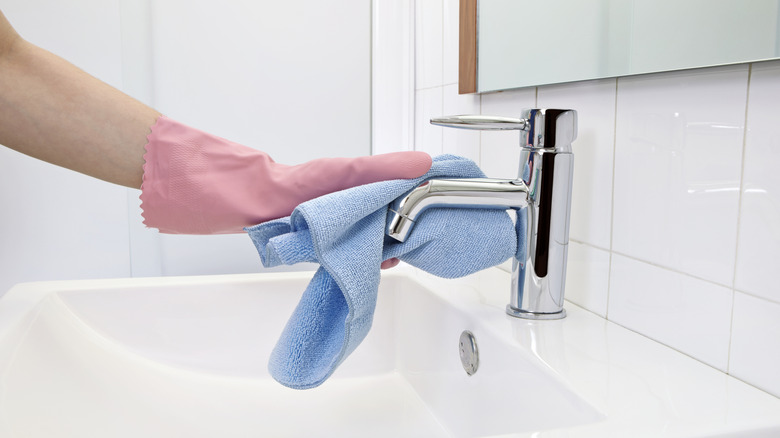The Truth About Why Microfiber Cloths Don't Clean As Well As You Want
Made of ultra-fine synthetic fibers, microfiber is a cleaning powerhouse with its soft, gentle texture and durability. The fibers are split, increasing surface area and making it easier for the material to grab small particles. So why is your cloth failing to clean properly? You might be using the wrong type of microfiber cloths. That's right: there are many different types of microfiber, from different weights to variations in the weave type. A medium-weight cloth with a terry or waffle-weave pattern performs well for general cleaning.
The weight of microfiber is described as grams per square meter (GSM). A higher GSM rating means the cloth is heavier and more absorbent. Cloths with a GSM between 300 and 400 offer light cleaning capabilities, such as dusting. For the bulk of your cleaning, you want a medium GSM between 400 and 500 for ideal absorbency without being overly heavy. Cloths with a GSM of 500 or higher absorb more liquid and are handy for big messes, making cleaning up spills simple and satisfying. Regardless of the GSM, a cloth made of 80% polyester and 20% polyamide works best.
The texture or pile impacts how well the cloth cleans. A shorter, terry-style weave has less resistance, so it's easier to move across surfaces. Plush microfiber cloths have a longer pile, which makes it gentler on surfaces, but it often has drag. Waffle-weave cloths absorb water quickly because the ridges create more vertical lines. Grab them for cleaning glass for a streak-free finish.
Other reasons your microfiber cloth might not clean well
Dirty microfiber cloths may make your surfaces dirtier by redistributing the gunk. Toss microfiber cloths in the washing machine with just a little gentle liquid detergent in a warm water cycle. You can put them in the dryer on a heat-free setting. More importantly, remember the common laundry mistakes that are ruining your microfiber cloths. Using bleach, fabric softener, dryer sheets, or powdered detergent damages the fabric and makes it unable to clean like normal. For the best results, wash microfiber cloths alone. Adding cotton items to the wash cycle clogs the microfiber.
Changing how you use your microfiber cloths can also improve your results. You don't need to add much water to a microfiber cloth when you're cleaning. If you do, you'll just move the water around without absorbing the liquid and dirt. Shaking out the microfiber cloths regularly while you're using them helps get rid of the dirt and debris they pick up. If you still see particles in the fibers, try a lint roller, brush, masking tape, or tweezers to remove them.
If your microfiber cloths still aren't cleaning well, they could be past their prime. You should be able to wash high-quality microfiber cloths about 500 times before retiring them if you take care of them properly. When you replace your cloths, consider a microfiber towel color coding system to separate cleaning cloths for different spaces. This minimizes contaminating your home with germs from different areas.

